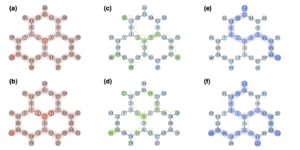Blog
Finding solutions to real quantum chemistry problems
What is quantum chemistry?
Quantum chemistry is a field in which quantum mechanics is used to understand chemical systems. A central problem is solving the Electronic Structure Problem, defined as finding stationary states of the non-relativistic time-independent electronic Schrödinger equation. In the so-called Born-Oppenheimer approximation electron-electron as well as electron-nuclei interactions are taken into account for a fixed set of coordinates of nuclei and the and the electronic configuration with the lowest energy is sought. This is a highly non-trivial task, and quantum computers are expected to be useful in solving this problem following very simple and natural reasoning: quantum problems require quantum methods for solving them.
Why is this problem interesting? Solving problems that appear in quantum chemistry will contribute to opening new pathways within drug discovery, a process in which potential medications are identified. This will help us reshape the future of healthcare and life sciences. A necessary step in solving the Electronic Structure Problem is finding a quantum circuit that can be executed on a quantum computer that represents our solution. The solution workflow itself breaks down into three central questions:
- • Problems that exist in quantum chemistry are naturally defined for fermionic systems, a natural framework for describing quantum chemistry problems in particular. How can we translate quantum chemistry problems to make them accessible for a quantum computing framework?
- • Given a particular problem, how do we efficiently solve it using as little resources and time as possible yet reaching satisfactory precision? In terms of quantum computing, it often boils down to the question: how to find an efficient quantum circuit that represents the solution to the problem?
- • Even the best quantum solution to the problem is useless if it is not executable on quantum hardware. Therefore, it is necessary to understand how to compile the quantum circuit onto a quantum machine to eventually extract the necessary information about the quantum state.
Fermion to qubit mappings – translating quantum chemistry problems for quantum computers
\( H = \sum_{p,q} h_{p,q} a_p^\dagger a_q + \sum_{p,q,r,s} h_{p,q,r,s} a_p^\dagger a_q^\dagger a_ra_s \).
This representation, while having convenient interpretation, is unfortunately not directly useful for quantum computing which usually prefers Hamiltonians expressed as a linear combination of Pauli operators. Thus a transformation commonly called Fermion-to-qubit mapping is needed. So far many Fermion-to-qubit mappings have been proposed, including Jordan-Wigner, Bravyi-Kitaev, and Ternary tree mappings. All of those have some pros and cons, in particular affecting the form of the quantum circuit representing a solution to the problem or the variance of energy estimation given a Hamiltonian.
Our main contribution to the field was the design of a large class of PPTT Fermion-to-qubit mappings generated through the Bonsai algorithm [1], that greatly expands the space of so-far considered mappings, including the ones mentioned in the previous paragraph. Such mappings can be easily designed based on a labeled ternary tree, which allows an efficient compilation of the quantum circuit if it is a proper subgraph of the quantum hardware architecture. As an example: One can check below the qubits involved in the so-called single- and double-excitation operations (marked by the shaded areas) in Jordan-Wigner (a,b), Ternary-Tree (c,d) and a particular PPTT mapping (e,f) for the heavy-hexagonal connectivity, the one usually used in IBM machines. We can clearly see that the PPTT mapping, while keeping the number of involved qubits small, also keeps them compact.

Qubits involved when implementing single and double excitations for Jordan-Wigner (left), Ternary-Tree (middle) and PPTT mapping (right), operations typically used for solving quantum chemistry problems.
PPTT mappings have much more properties than promising a compact set of qubits for important operations. In addition to this, they guarantee that all the Fock basic states, including the Hartree-Fock state, can be very easily implemented on a quantum computer by just one-qubit operations. This is important as Hartree-Fock states are good starting points for variational quantum algorithms. In addition, PPTT mappings from our experience generate representations of the quantum chemistry Hamiltonians in the qubit space for which the expectation values can be easily measured, see our [blog post on efficient energy estimation].
AIM-ADAPT-VQE – shot-efficient solution building for quantum chemistry
With the current noisy quantum computers available, the community of quantum computer scientists focuses on a large family of Variational Quantum Eigensolvers (VQE). VQE is a method that pre-selects, or designs on the fly, an ansatz that supposedly describes the solution of a given problem at hand. For example, for a given quantum-chemical Hamiltonian (see equation above), the parameters are optimized such that the resulting quantum state minimizes the energy of the provided Hamiltonian.
While all of the VQE frameworks roughly share the above details, there are many critical aspects that determine whether a particular variant of the algorithm is able to find the ground state. In particular, the choice of the ansatz is critical, while many of the approaches focus on choosing the ansatz that takes into account available connectivity of the quantum hardware, but also possible difficulties like the presence of barren plateaus. Our main current focus is a large family of ADAPT-VQE methods [2], in which for a given intermediate ansatz, a pool of gate candidates is investigated to select the one that improves the ansatz the most. Many pools have been proposed so far, including fermionic-spin, QEB, qubit, or the Majoranic pool introduced by us. A common property of these pools, resulting from the natural atomic evolution that can be defined in the fermionic system, is that the number of elements in the pool grows very quickly: for $N$ qubits, the typical size observed is $O(N^4)$, which although polynomial, grows significantly with the problem size. The original ADAPT-VQE proposed to qualify each gate candidate using quantum computers, which while efficient in principle, is rather prohibitive due to the large number of elements in the pool.
Our proposal, AIM-ADAPT-VQE [3], is to use Informationally complete measurements (IC-POVMs) to greatly mitigate the number of quantum circuits run. IC-POVMs provide not only an efficient energy estimation routine but also provide us with an unbiased estimation of the quantum state being measured. This way, we can continue evolving our quantum state using conventional, classical resources only. While for fundamental reasons it is likely impossible to perform complicated investigations, the ADAPT-VQE routine requires only simple enough evolution just enough to allow an effective pool selection procedure.

Flowchart of the AIM-ADAPT-VQE, a method for obtaining ground states of quantum chemistry Hamiltonians.
Efficient compilation of quantum chemistry solutions to quantum computer
Ansätze as constructed by AIM-ADAPT-VQE or other methods often consists of complicated multi-qubit operations that cannot be directly implemented on gate-based quantum computers. Therefore it is necessary to compile the quantum circuit into the native language of the machine, which usually allows at most two-qubit operations (like CNOT) only for some pairs of qubits. While there are methods that allow us to mitigate the error that appears on the machines like TEM or Zero Noise Extrapolation (ZNE), eventually smaller circuits lead to smaller errors, and thus allow for more effective mitigation. Luckily the gates usually used in ADAPT-VQE procedures are easy to implement so many of the existing compilation methods can be used.
With our family of PPTT Fermion-to-qubit mappings, we can go one abstraction level higher than this. Instead of focusing only on efficient transpilation method for a given quantum state, we look back into its fermionic representation, we adjust the Fermion-to-qubit mapping to find a new one that would provide more compact representation of the quantum state [4]. Such routine is repeated many times in order to find the best mapping that optimizes a particular cost, whether the Hamiltonian or ansatz complexity. Treespilation, which is how we call our PPTT mappings optimization procedure, proved to be a valuable asset for optimizing qubit representation of fermionic states, greatly decreasing number of 2-qubit gates:

Summary
A central problem of quantum chemistry, the Electronic Structure Problem is known to be a difficult problem and is believed to be efficiently solvable with quantum computers. This in turn is vital, because understanding molecular Hamiltonians can be reduced to Electronic Structure Problem. Effective simulations of the molecular properties and chemistry of drug candidate molecules can open up new pathways to make the drug discovery process more targeted and reliable. However, for this we need to be able to efficiently find solutions to Electronic Structure Problem, and as mentioned before quantum computing is a particular strong candidate. In Algorithmiq, we are dedicated to finding resourceful methods for an efficient representation of the problem in qubit-space, preparation of the quantum solution, and its execution on the quantum computers. Our carefully designed methodology, which takes advantage of the fermionic aspects of the problem as much as possible, allows us to find solutions with low cost in the quantum resources, including a reduction of the complexity of the quantum circuit as well as the number of times a quantum circuit needs to be executed on hardware.
References
- 1. Miller, Aaron, et al. “Bonsai algorithm: Grow your own fermion-to-qubit mappings.” PRX Quantum 4.3 (2023): 030314.
- 2. Grimsley, Harper R., et al. “Adapt-vqe: An exact variational algorithm for fermionic simulations on a quantum computer.” arXiv preprint arXiv:1812.11173 (2018).
- 3. Nykänen, Anton, et al. “Mitigating the measurement overhead of ADAPT-VQE with optimised informationally complete generalised measurements.” arXiv preprint arXiv:2212.09719 (2022).
- 4. Miller, Aaron, Adam Glos, and Zoltán Zimborás. “Treespilation: Architecture-and State-Optimised Fermion-to-Qubit Mappings.” arXiv preprint arXiv:2403.03992 (2024).
Author
 Adam Glos
Adam Glos
Lead Researcher in Algorithmiq and PhD in computer science
Contributions
PPTT mappings generation, AIM-ADAPT-VQE, and treespilation are part of Algorithmiq’s software platform Aurora. Elements of the treespliation technique are patent pending. Special thanks to Stefan Knecht, Özlem Salehi, Aaron Miller and Anton Nykänen for valuable comments to this blog.
